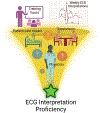Predictors of ECG Interpretation Proficiency in Healthcare Professionals
- PMID: 37544624
- PMCID: PMC10838348
- DOI: 10.1016/j.cpcardiol.2023.102011
Predictors of ECG Interpretation Proficiency in Healthcare Professionals
Abstract
Accurate ECG interpretation is vital, but variations in skills exist among healthcare professionals. This study aims to identify factors contributing to ECG interpretation proficiency. Survey data and ECG interpretation test scores from participants in the EDUCATE Trial were analyzed to identify predictors of performance for 30 sequential 12-lead ECGs. Nonmodifiable factors (being a physician, clinical experience, patient care impact) and modifiable factors (weekly interpretation volume, training hours, expert supervision frequency) were analyzed. Bivariate and multivariate analyses were used to generate a Comprehensive Model (incorporating all factors) and Actionable Model (incorporating modifiable factors only). Among 1206 participants analyzed, there were 72 (6.0%) primary care physicians, 146 (12.1%) cardiology fellows-in-training, 353 (29.3%) resident physicians, 182 (15.1%) medical students, 84 (7.0%) advanced practice providers, 120 (9.9%) nurses, and 249 (20.7%) allied health professionals. Among them, 571 (47.3%) were physicians and 453 (37.6%) were nonphysicians. The average test score was 56.4% ± 17.2%. Bivariate analysis demonstrated significant associations between test scores and >10 weekly ECG interpretations, being a physician, >5 training hours, patient care impact, and expert supervision but not clinical experience. In the Comprehensive Model, independent associations were found with weekly interpretation volume (9.9 score increase; 95% CI, 7.9-11.8; P < 0.001), being a physician (9.0 score increase; 95% CI, 7.2-10.8; P < 0.001), and training hours (5.7 score increase; 95% CI, 3.7-7.6; P < 0.001). In the Actionable Model, scores were independently associated with weekly interpretation volume (12.0 score increase; 95% CI, 10.0-14.0; P < 0.001) and training hours (4.7 score increase; 95% CI, 2.6-6.7; P < 0.001). The Comprehensive and Actionable Models explained 18.7% and 12.3% of the variance in test scores, respectively. Predictors of ECG interpretation proficiency include nonmodifiable factors like physician status and modifiable factors such as training hours and weekly ECG interpretation volume.
Copyright © 2023 Elsevier Inc. All rights reserved.
Conflict of interest statement
Declaration of Competing Interest The authors declare the following financial interests/personal relationships which may be considered as potential competing interests: Author (Anthony Kashou, MD) is the founder and CEO of The EKG Guy and has received research funding from GE HealthCare (Milwaukee, WI).
Figures
References
-
- Hatala RA, Norman GR, Brooks LR. The effect of clinical history on physicians’ ECG interpretation skills. Acad Med 71:S68–S70, 1996 - PubMed
-
- Çıkrıkçı Isık G, Şafak T, et al. Effectiveness of the CRISP method on the primary cardiac arrhythmia interpretation accuracy of nurses. Journal of Continuing Education in Nursing 51:574–580, 2020 - PubMed
Publication types
MeSH terms
Grants and funding
LinkOut - more resources
Full Text Sources


